An Empirical Study: Rounded Price Influence on Consumer Behavior
VerifiedAdded on 2023/01/06
|18
|5897
|88
Report
AI Summary
This empirical research project investigates the 'Rounded Price Influence,' which posits that consumers' purchasing probability can be affected by the roundness of a price, particularly in contexts where a 'feeling right' is established. The study validates these effects and explores the manipulation of this impact. The research includes an introduction discussing the importance of pricing, research aims, objectives, and hypotheses. A comprehensive literature review examines existing research on price perception and its effect on consumer behavior. The methodology section outlines the experimental design used to test the rounded price effect, followed by the presentation of results, discussion, and references. The findings suggest that rounded prices can influence consumer choices, and even priming consumers with rounded figures can contribute to the observed effect. The study provides converging support for the rounding risk premium and offers insights for advertisers and marketers seeking to optimize pricing strategies. The report also explores the concept of the circular price effect, where the match between price roundness and the context of the purchase influences consumer responses. This research contributes to a better understanding of how price presentation influences consumer behavior and purchasing decisions.
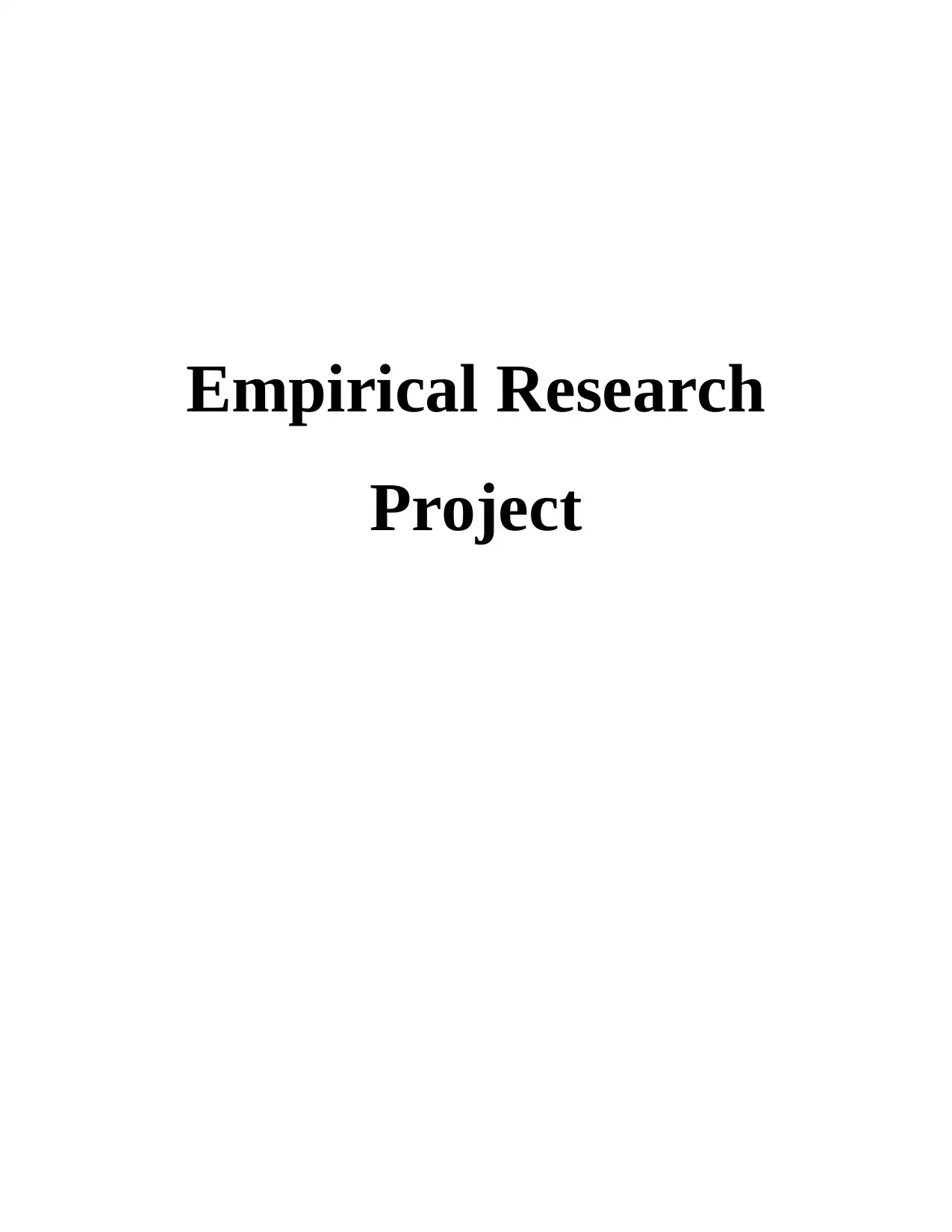
Empirical Research
Project
Project
Paraphrase This Document
Need a fresh take? Get an instant paraphrase of this document with our AI Paraphraser
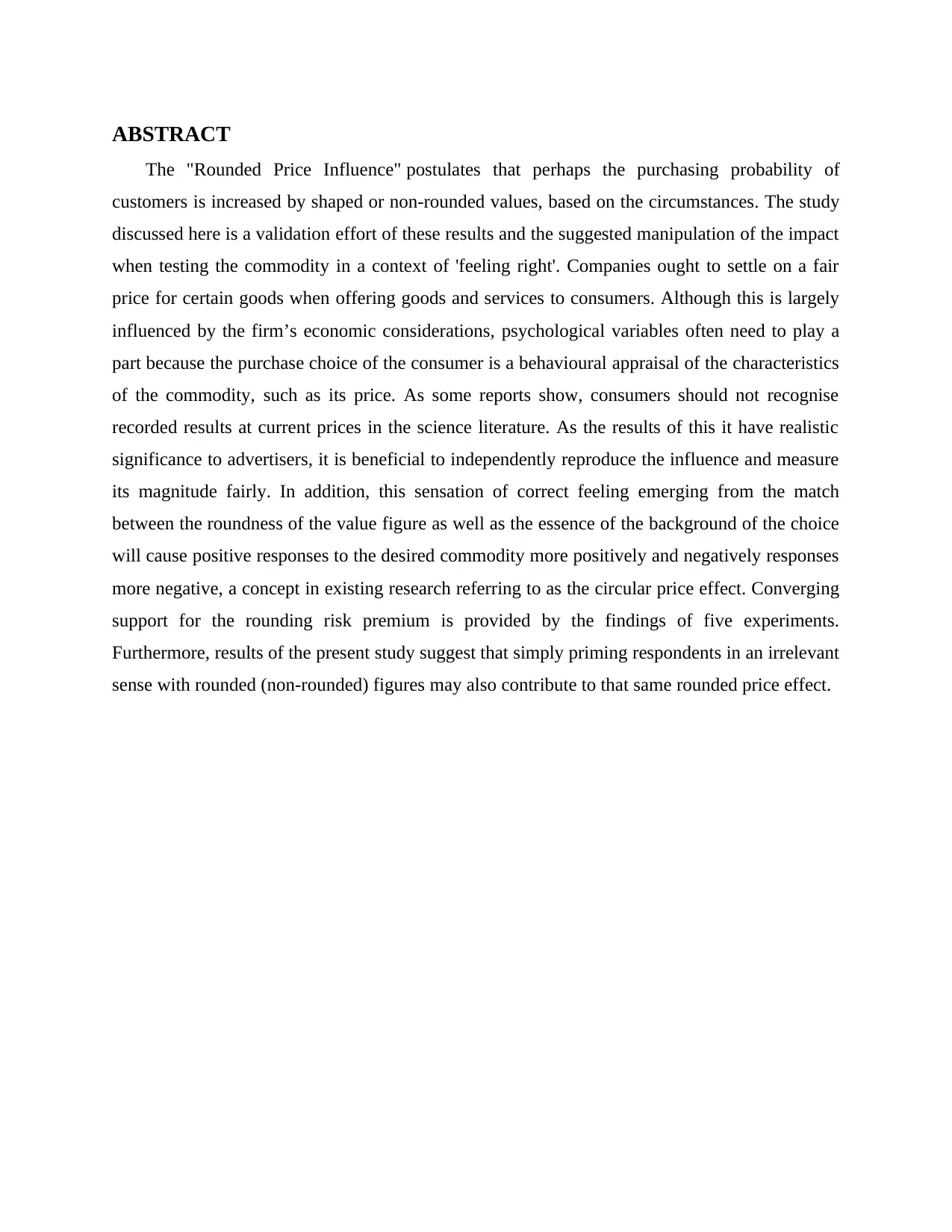
ABSTRACT
The "Rounded Price Influence" postulates that perhaps the purchasing probability of
customers is increased by shaped or non-rounded values, based on the circumstances. The study
discussed here is a validation effort of these results and the suggested manipulation of the impact
when testing the commodity in a context of 'feeling right'. Companies ought to settle on a fair
price for certain goods when offering goods and services to consumers. Although this is largely
influenced by the firm’s economic considerations, psychological variables often need to play a
part because the purchase choice of the consumer is a behavioural appraisal of the characteristics
of the commodity, such as its price. As some reports show, consumers should not recognise
recorded results at current prices in the science literature. As the results of this it have realistic
significance to advertisers, it is beneficial to independently reproduce the influence and measure
its magnitude fairly. In addition, this sensation of correct feeling emerging from the match
between the roundness of the value figure as well as the essence of the background of the choice
will cause positive responses to the desired commodity more positively and negatively responses
more negative, a concept in existing research referring to as the circular price effect. Converging
support for the rounding risk premium is provided by the findings of five experiments.
Furthermore, results of the present study suggest that simply priming respondents in an irrelevant
sense with rounded (non-rounded) figures may also contribute to that same rounded price effect.
The "Rounded Price Influence" postulates that perhaps the purchasing probability of
customers is increased by shaped or non-rounded values, based on the circumstances. The study
discussed here is a validation effort of these results and the suggested manipulation of the impact
when testing the commodity in a context of 'feeling right'. Companies ought to settle on a fair
price for certain goods when offering goods and services to consumers. Although this is largely
influenced by the firm’s economic considerations, psychological variables often need to play a
part because the purchase choice of the consumer is a behavioural appraisal of the characteristics
of the commodity, such as its price. As some reports show, consumers should not recognise
recorded results at current prices in the science literature. As the results of this it have realistic
significance to advertisers, it is beneficial to independently reproduce the influence and measure
its magnitude fairly. In addition, this sensation of correct feeling emerging from the match
between the roundness of the value figure as well as the essence of the background of the choice
will cause positive responses to the desired commodity more positively and negatively responses
more negative, a concept in existing research referring to as the circular price effect. Converging
support for the rounding risk premium is provided by the findings of five experiments.
Furthermore, results of the present study suggest that simply priming respondents in an irrelevant
sense with rounded (non-rounded) figures may also contribute to that same rounded price effect.
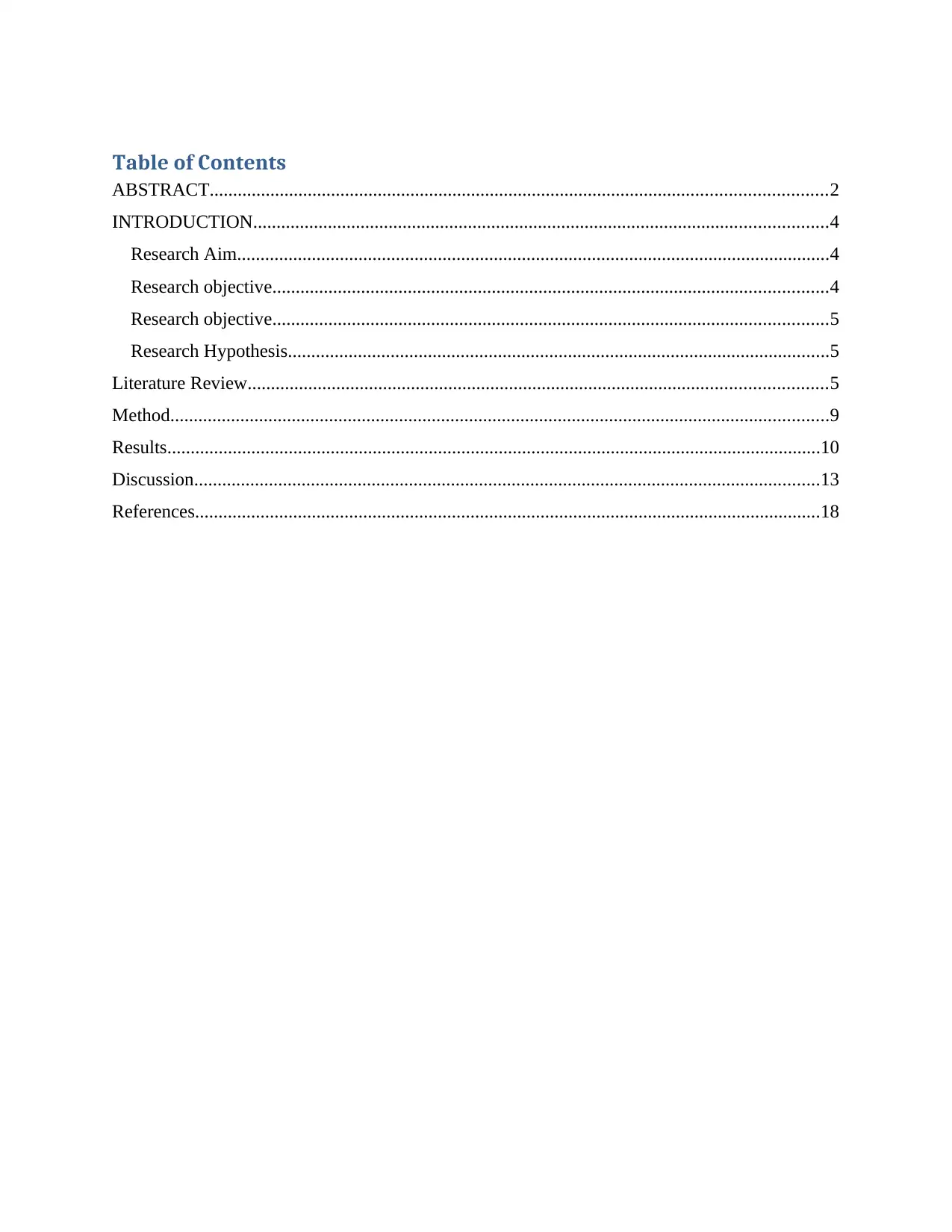
Table of Contents
ABSTRACT....................................................................................................................................2
INTRODUCTION...........................................................................................................................4
Research Aim...............................................................................................................................4
Research objective.......................................................................................................................4
Research objective.......................................................................................................................5
Research Hypothesis....................................................................................................................5
Literature Review............................................................................................................................5
Method.............................................................................................................................................9
Results............................................................................................................................................10
Discussion......................................................................................................................................13
References......................................................................................................................................18
ABSTRACT....................................................................................................................................2
INTRODUCTION...........................................................................................................................4
Research Aim...............................................................................................................................4
Research objective.......................................................................................................................4
Research objective.......................................................................................................................5
Research Hypothesis....................................................................................................................5
Literature Review............................................................................................................................5
Method.............................................................................................................................................9
Results............................................................................................................................................10
Discussion......................................................................................................................................13
References......................................................................................................................................18
⊘ This is a preview!⊘
Do you want full access?
Subscribe today to unlock all pages.

Trusted by 1+ million students worldwide
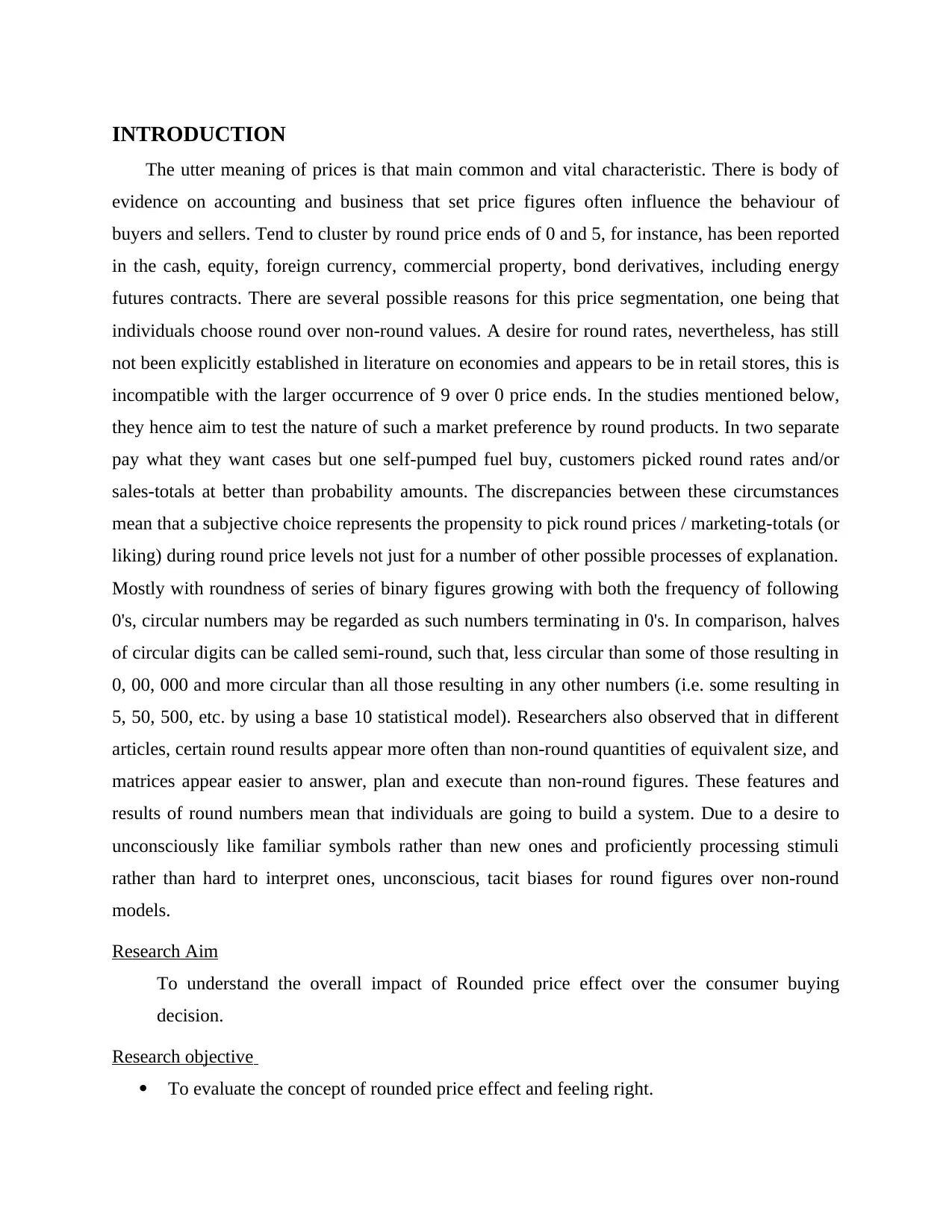
INTRODUCTION
The utter meaning of prices is that main common and vital characteristic. There is body of
evidence on accounting and business that set price figures often influence the behaviour of
buyers and sellers. Tend to cluster by round price ends of 0 and 5, for instance, has been reported
in the cash, equity, foreign currency, commercial property, bond derivatives, including energy
futures contracts. There are several possible reasons for this price segmentation, one being that
individuals choose round over non-round values. A desire for round rates, nevertheless, has still
not been explicitly established in literature on economies and appears to be in retail stores, this is
incompatible with the larger occurrence of 9 over 0 price ends. In the studies mentioned below,
they hence aim to test the nature of such a market preference by round products. In two separate
pay what they want cases but one self-pumped fuel buy, customers picked round rates and/or
sales-totals at better than probability amounts. The discrepancies between these circumstances
mean that a subjective choice represents the propensity to pick round prices / marketing-totals (or
liking) during round price levels not just for a number of other possible processes of explanation.
Mostly with roundness of series of binary figures growing with both the frequency of following
0's, circular numbers may be regarded as such numbers terminating in 0's. In comparison, halves
of circular digits can be called semi-round, such that, less circular than some of those resulting in
0, 00, 000 and more circular than all those resulting in any other numbers (i.e. some resulting in
5, 50, 500, etc. by using a base 10 statistical model). Researchers also observed that in different
articles, certain round results appear more often than non-round quantities of equivalent size, and
matrices appear easier to answer, plan and execute than non-round figures. These features and
results of round numbers mean that individuals are going to build a system. Due to a desire to
unconsciously like familiar symbols rather than new ones and proficiently processing stimuli
rather than hard to interpret ones, unconscious, tacit biases for round figures over non-round
models.
Research Aim
To understand the overall impact of Rounded price effect over the consumer buying
decision.
Research objective
To evaluate the concept of rounded price effect and feeling right.
The utter meaning of prices is that main common and vital characteristic. There is body of
evidence on accounting and business that set price figures often influence the behaviour of
buyers and sellers. Tend to cluster by round price ends of 0 and 5, for instance, has been reported
in the cash, equity, foreign currency, commercial property, bond derivatives, including energy
futures contracts. There are several possible reasons for this price segmentation, one being that
individuals choose round over non-round values. A desire for round rates, nevertheless, has still
not been explicitly established in literature on economies and appears to be in retail stores, this is
incompatible with the larger occurrence of 9 over 0 price ends. In the studies mentioned below,
they hence aim to test the nature of such a market preference by round products. In two separate
pay what they want cases but one self-pumped fuel buy, customers picked round rates and/or
sales-totals at better than probability amounts. The discrepancies between these circumstances
mean that a subjective choice represents the propensity to pick round prices / marketing-totals (or
liking) during round price levels not just for a number of other possible processes of explanation.
Mostly with roundness of series of binary figures growing with both the frequency of following
0's, circular numbers may be regarded as such numbers terminating in 0's. In comparison, halves
of circular digits can be called semi-round, such that, less circular than some of those resulting in
0, 00, 000 and more circular than all those resulting in any other numbers (i.e. some resulting in
5, 50, 500, etc. by using a base 10 statistical model). Researchers also observed that in different
articles, certain round results appear more often than non-round quantities of equivalent size, and
matrices appear easier to answer, plan and execute than non-round figures. These features and
results of round numbers mean that individuals are going to build a system. Due to a desire to
unconsciously like familiar symbols rather than new ones and proficiently processing stimuli
rather than hard to interpret ones, unconscious, tacit biases for round figures over non-round
models.
Research Aim
To understand the overall impact of Rounded price effect over the consumer buying
decision.
Research objective
To evaluate the concept of rounded price effect and feeling right.
Paraphrase This Document
Need a fresh take? Get an instant paraphrase of this document with our AI Paraphraser
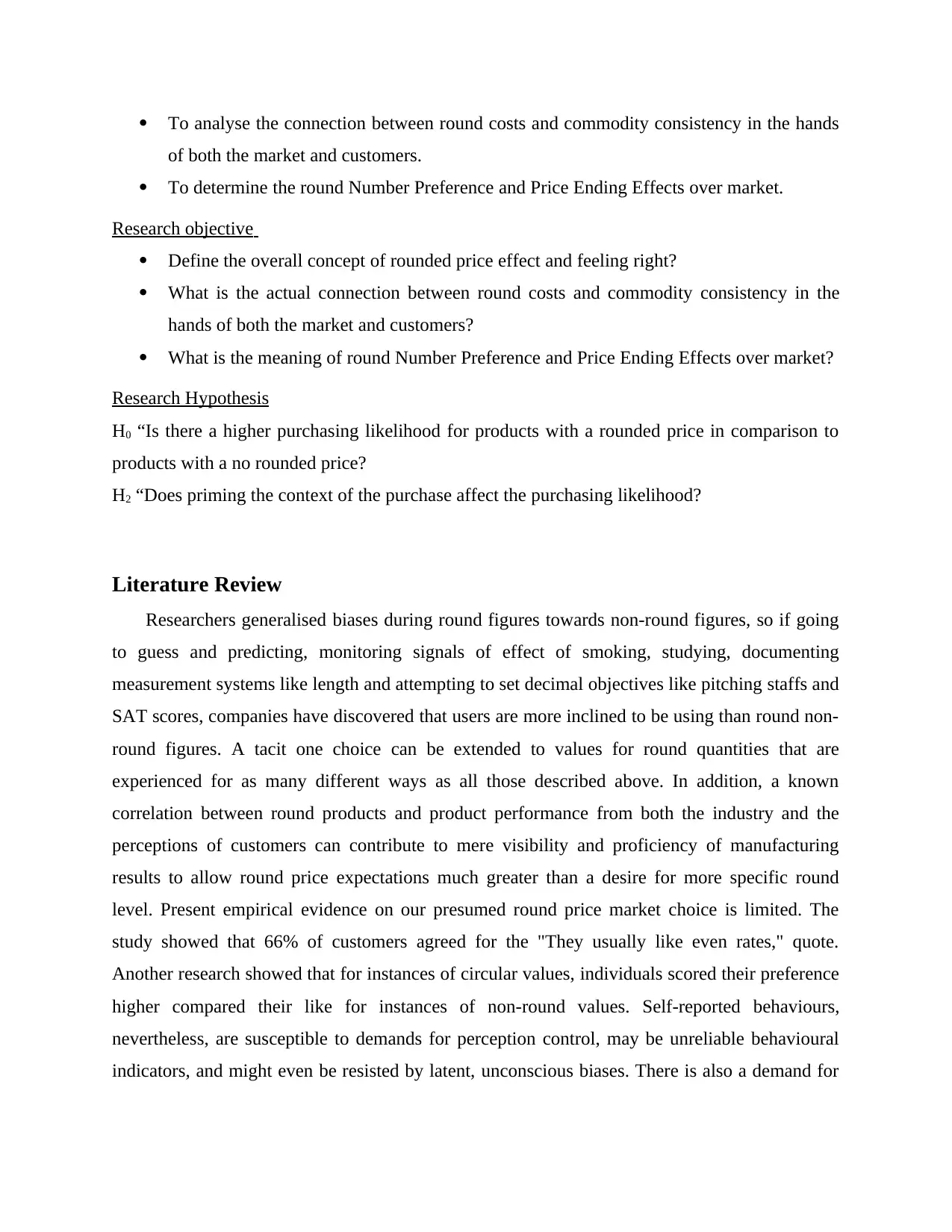
To analyse the connection between round costs and commodity consistency in the hands
of both the market and customers.
To determine the round Number Preference and Price Ending Effects over market.
Research objective
Define the overall concept of rounded price effect and feeling right?
What is the actual connection between round costs and commodity consistency in the
hands of both the market and customers?
What is the meaning of round Number Preference and Price Ending Effects over market?
Research Hypothesis
H0 “Is there a higher purchasing likelihood for products with a rounded price in comparison to
products with a no rounded price?
H2 “Does priming the context of the purchase affect the purchasing likelihood?
Literature Review
Researchers generalised biases during round figures towards non-round figures, so if going
to guess and predicting, monitoring signals of effect of smoking, studying, documenting
measurement systems like length and attempting to set decimal objectives like pitching staffs and
SAT scores, companies have discovered that users are more inclined to be using than round non-
round figures. A tacit one choice can be extended to values for round quantities that are
experienced for as many different ways as all those described above. In addition, a known
correlation between round products and product performance from both the industry and the
perceptions of customers can contribute to mere visibility and proficiency of manufacturing
results to allow round price expectations much greater than a desire for more specific round
level. Present empirical evidence on our presumed round price market choice is limited. The
study showed that 66% of customers agreed for the "They usually like even rates," quote.
Another research showed that for instances of circular values, individuals scored their preference
higher compared their like for instances of non-round values. Self-reported behaviours,
nevertheless, are susceptible to demands for perception control, may be unreliable behavioural
indicators, and might even be resisted by latent, unconscious biases. There is also a demand for
of both the market and customers.
To determine the round Number Preference and Price Ending Effects over market.
Research objective
Define the overall concept of rounded price effect and feeling right?
What is the actual connection between round costs and commodity consistency in the
hands of both the market and customers?
What is the meaning of round Number Preference and Price Ending Effects over market?
Research Hypothesis
H0 “Is there a higher purchasing likelihood for products with a rounded price in comparison to
products with a no rounded price?
H2 “Does priming the context of the purchase affect the purchasing likelihood?
Literature Review
Researchers generalised biases during round figures towards non-round figures, so if going
to guess and predicting, monitoring signals of effect of smoking, studying, documenting
measurement systems like length and attempting to set decimal objectives like pitching staffs and
SAT scores, companies have discovered that users are more inclined to be using than round non-
round figures. A tacit one choice can be extended to values for round quantities that are
experienced for as many different ways as all those described above. In addition, a known
correlation between round products and product performance from both the industry and the
perceptions of customers can contribute to mere visibility and proficiency of manufacturing
results to allow round price expectations much greater than a desire for more specific round
level. Present empirical evidence on our presumed round price market choice is limited. The
study showed that 66% of customers agreed for the "They usually like even rates," quote.
Another research showed that for instances of circular values, individuals scored their preference
higher compared their like for instances of non-round values. Self-reported behaviours,
nevertheless, are susceptible to demands for perception control, may be unreliable behavioural
indicators, and might even be resisted by latent, unconscious biases. There is also a demand for
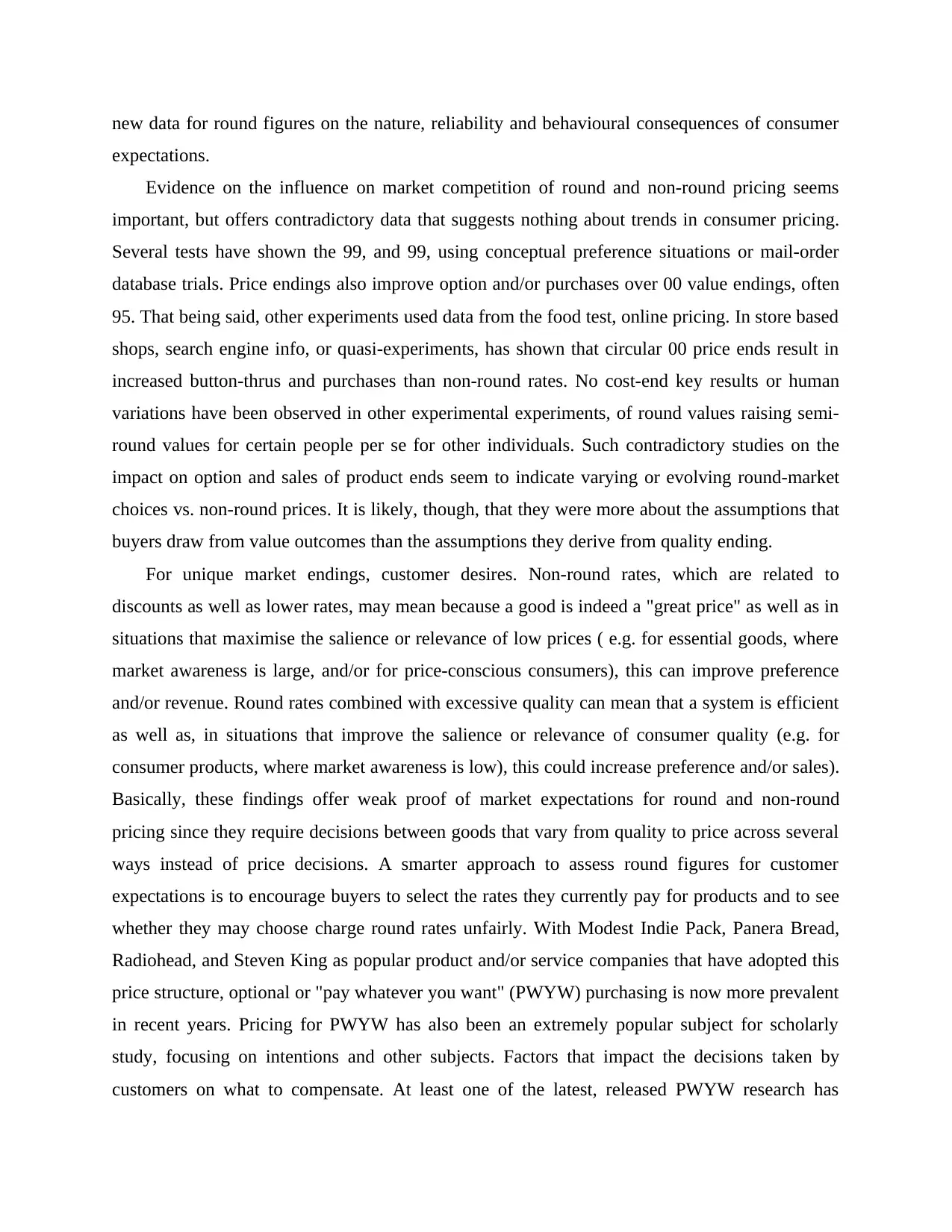
new data for round figures on the nature, reliability and behavioural consequences of consumer
expectations.
Evidence on the influence on market competition of round and non-round pricing seems
important, but offers contradictory data that suggests nothing about trends in consumer pricing.
Several tests have shown the 99, and 99, using conceptual preference situations or mail-order
database trials. Price endings also improve option and/or purchases over 00 value endings, often
95. That being said, other experiments used data from the food test, online pricing. In store based
shops, search engine info, or quasi-experiments, has shown that circular 00 price ends result in
increased button-thrus and purchases than non-round rates. No cost-end key results or human
variations have been observed in other experimental experiments, of round values raising semi-
round values for certain people per se for other individuals. Such contradictory studies on the
impact on option and sales of product ends seem to indicate varying or evolving round-market
choices vs. non-round prices. It is likely, though, that they were more about the assumptions that
buyers draw from value outcomes than the assumptions they derive from quality ending.
For unique market endings, customer desires. Non-round rates, which are related to
discounts as well as lower rates, may mean because a good is indeed a "great price" as well as in
situations that maximise the salience or relevance of low prices ( e.g. for essential goods, where
market awareness is large, and/or for price-conscious consumers), this can improve preference
and/or revenue. Round rates combined with excessive quality can mean that a system is efficient
as well as, in situations that improve the salience or relevance of consumer quality (e.g. for
consumer products, where market awareness is low), this could increase preference and/or sales).
Basically, these findings offer weak proof of market expectations for round and non-round
pricing since they require decisions between goods that vary from quality to price across several
ways instead of price decisions. A smarter approach to assess round figures for customer
expectations is to encourage buyers to select the rates they currently pay for products and to see
whether they may choose charge round rates unfairly. With Modest Indie Pack, Panera Bread,
Radiohead, and Steven King as popular product and/or service companies that have adopted this
price structure, optional or "pay whatever you want" (PWYW) purchasing is now more prevalent
in recent years. Pricing for PWYW has also been an extremely popular subject for scholarly
study, focusing on intentions and other subjects. Factors that impact the decisions taken by
customers on what to compensate. At least one of the latest, released PWYW research has
expectations.
Evidence on the influence on market competition of round and non-round pricing seems
important, but offers contradictory data that suggests nothing about trends in consumer pricing.
Several tests have shown the 99, and 99, using conceptual preference situations or mail-order
database trials. Price endings also improve option and/or purchases over 00 value endings, often
95. That being said, other experiments used data from the food test, online pricing. In store based
shops, search engine info, or quasi-experiments, has shown that circular 00 price ends result in
increased button-thrus and purchases than non-round rates. No cost-end key results or human
variations have been observed in other experimental experiments, of round values raising semi-
round values for certain people per se for other individuals. Such contradictory studies on the
impact on option and sales of product ends seem to indicate varying or evolving round-market
choices vs. non-round prices. It is likely, though, that they were more about the assumptions that
buyers draw from value outcomes than the assumptions they derive from quality ending.
For unique market endings, customer desires. Non-round rates, which are related to
discounts as well as lower rates, may mean because a good is indeed a "great price" as well as in
situations that maximise the salience or relevance of low prices ( e.g. for essential goods, where
market awareness is large, and/or for price-conscious consumers), this can improve preference
and/or revenue. Round rates combined with excessive quality can mean that a system is efficient
as well as, in situations that improve the salience or relevance of consumer quality (e.g. for
consumer products, where market awareness is low), this could increase preference and/or sales).
Basically, these findings offer weak proof of market expectations for round and non-round
pricing since they require decisions between goods that vary from quality to price across several
ways instead of price decisions. A smarter approach to assess round figures for customer
expectations is to encourage buyers to select the rates they currently pay for products and to see
whether they may choose charge round rates unfairly. With Modest Indie Pack, Panera Bread,
Radiohead, and Steven King as popular product and/or service companies that have adopted this
price structure, optional or "pay whatever you want" (PWYW) purchasing is now more prevalent
in recent years. Pricing for PWYW has also been an extremely popular subject for scholarly
study, focusing on intentions and other subjects. Factors that impact the decisions taken by
customers on what to compensate. At least one of the latest, released PWYW research has
⊘ This is a preview!⊘
Do you want full access?
Subscribe today to unlock all pages.

Trusted by 1+ million students worldwide
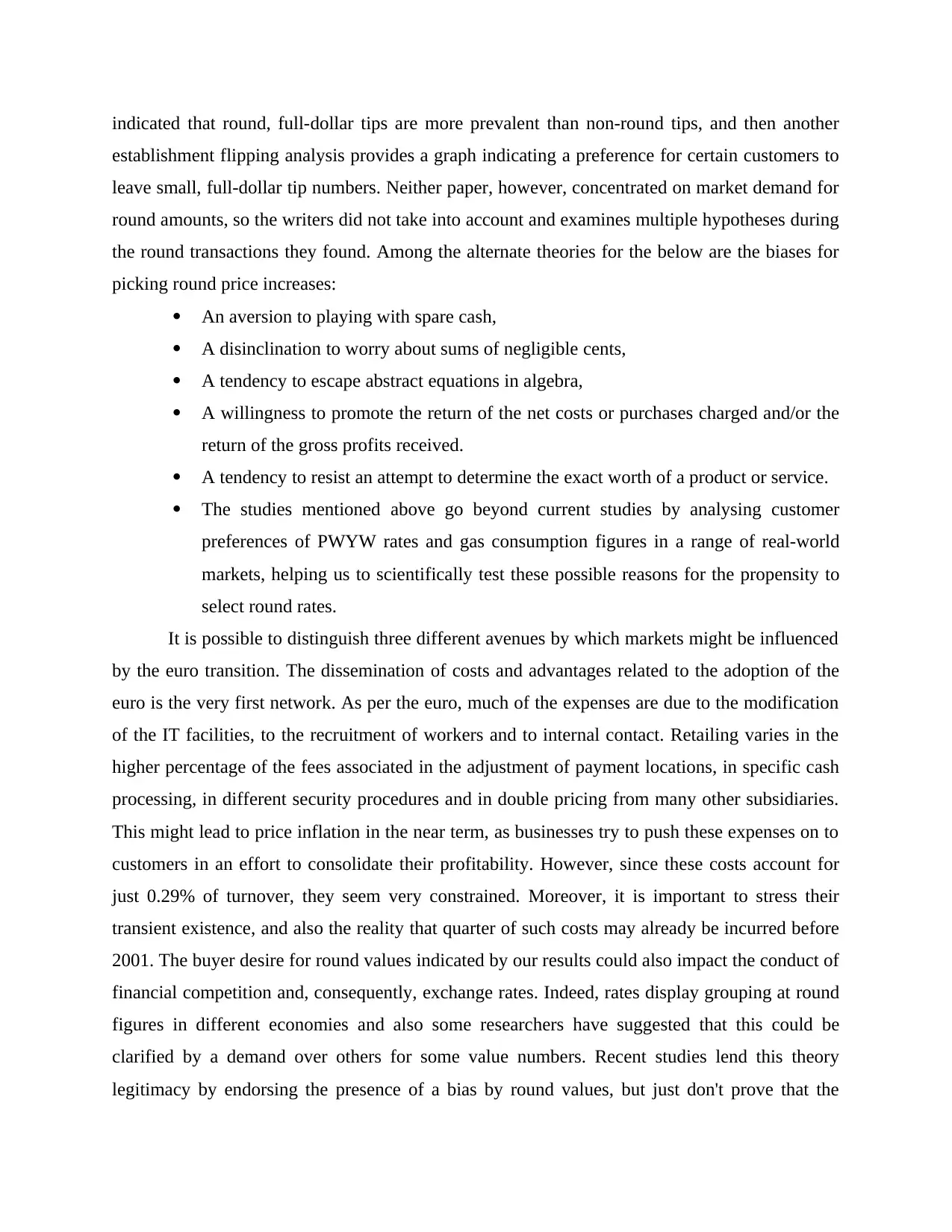
indicated that round, full-dollar tips are more prevalent than non-round tips, and then another
establishment flipping analysis provides a graph indicating a preference for certain customers to
leave small, full-dollar tip numbers. Neither paper, however, concentrated on market demand for
round amounts, so the writers did not take into account and examines multiple hypotheses during
the round transactions they found. Among the alternate theories for the below are the biases for
picking round price increases:
An aversion to playing with spare cash,
A disinclination to worry about sums of negligible cents,
A tendency to escape abstract equations in algebra,
A willingness to promote the return of the net costs or purchases charged and/or the
return of the gross profits received.
A tendency to resist an attempt to determine the exact worth of a product or service.
The studies mentioned above go beyond current studies by analysing customer
preferences of PWYW rates and gas consumption figures in a range of real-world
markets, helping us to scientifically test these possible reasons for the propensity to
select round rates.
It is possible to distinguish three different avenues by which markets might be influenced
by the euro transition. The dissemination of costs and advantages related to the adoption of the
euro is the very first network. As per the euro, much of the expenses are due to the modification
of the IT facilities, to the recruitment of workers and to internal contact. Retailing varies in the
higher percentage of the fees associated in the adjustment of payment locations, in specific cash
processing, in different security procedures and in double pricing from many other subsidiaries.
This might lead to price inflation in the near term, as businesses try to push these expenses on to
customers in an effort to consolidate their profitability. However, since these costs account for
just 0.29% of turnover, they seem very constrained. Moreover, it is important to stress their
transient existence, and also the reality that quarter of such costs may already be incurred before
2001. The buyer desire for round values indicated by our results could also impact the conduct of
financial competition and, consequently, exchange rates. Indeed, rates display grouping at round
figures in different economies and also some researchers have suggested that this could be
clarified by a demand over others for some value numbers. Recent studies lend this theory
legitimacy by endorsing the presence of a bias by round values, but just don't prove that the
establishment flipping analysis provides a graph indicating a preference for certain customers to
leave small, full-dollar tip numbers. Neither paper, however, concentrated on market demand for
round amounts, so the writers did not take into account and examines multiple hypotheses during
the round transactions they found. Among the alternate theories for the below are the biases for
picking round price increases:
An aversion to playing with spare cash,
A disinclination to worry about sums of negligible cents,
A tendency to escape abstract equations in algebra,
A willingness to promote the return of the net costs or purchases charged and/or the
return of the gross profits received.
A tendency to resist an attempt to determine the exact worth of a product or service.
The studies mentioned above go beyond current studies by analysing customer
preferences of PWYW rates and gas consumption figures in a range of real-world
markets, helping us to scientifically test these possible reasons for the propensity to
select round rates.
It is possible to distinguish three different avenues by which markets might be influenced
by the euro transition. The dissemination of costs and advantages related to the adoption of the
euro is the very first network. As per the euro, much of the expenses are due to the modification
of the IT facilities, to the recruitment of workers and to internal contact. Retailing varies in the
higher percentage of the fees associated in the adjustment of payment locations, in specific cash
processing, in different security procedures and in double pricing from many other subsidiaries.
This might lead to price inflation in the near term, as businesses try to push these expenses on to
customers in an effort to consolidate their profitability. However, since these costs account for
just 0.29% of turnover, they seem very constrained. Moreover, it is important to stress their
transient existence, and also the reality that quarter of such costs may already be incurred before
2001. The buyer desire for round values indicated by our results could also impact the conduct of
financial competition and, consequently, exchange rates. Indeed, rates display grouping at round
figures in different economies and also some researchers have suggested that this could be
clarified by a demand over others for some value numbers. Recent studies lend this theory
legitimacy by endorsing the presence of a bias by round values, but just don't prove that the
Paraphrase This Document
Need a fresh take? Get an instant paraphrase of this document with our AI Paraphraser
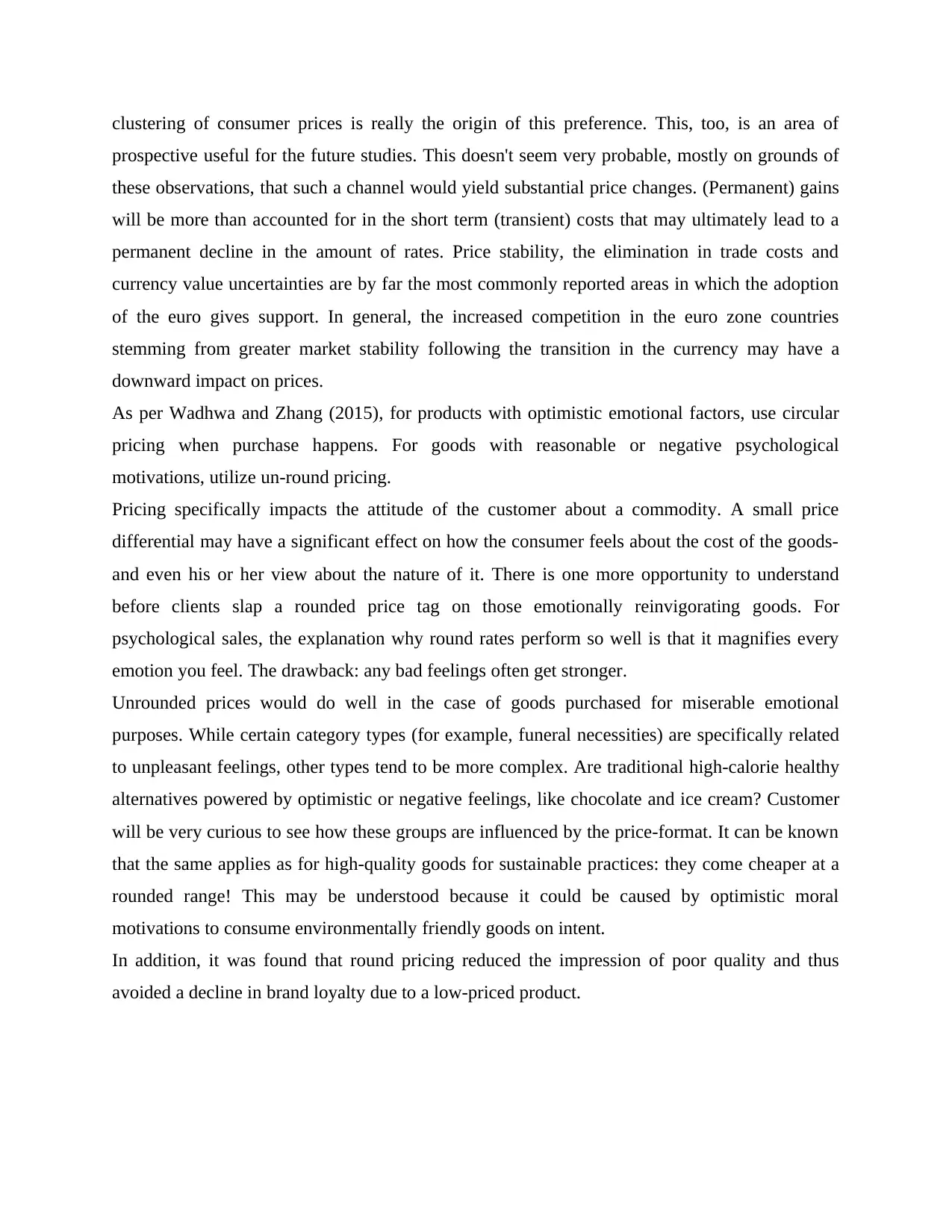
clustering of consumer prices is really the origin of this preference. This, too, is an area of
prospective useful for the future studies. This doesn't seem very probable, mostly on grounds of
these observations, that such a channel would yield substantial price changes. (Permanent) gains
will be more than accounted for in the short term (transient) costs that may ultimately lead to a
permanent decline in the amount of rates. Price stability, the elimination in trade costs and
currency value uncertainties are by far the most commonly reported areas in which the adoption
of the euro gives support. In general, the increased competition in the euro zone countries
stemming from greater market stability following the transition in the currency may have a
downward impact on prices.
As per Wadhwa and Zhang (2015), for products with optimistic emotional factors, use circular
pricing when purchase happens. For goods with reasonable or negative psychological
motivations, utilize un-round pricing.
Pricing specifically impacts the attitude of the customer about a commodity. A small price
differential may have a significant effect on how the consumer feels about the cost of the goods-
and even his or her view about the nature of it. There is one more opportunity to understand
before clients slap a rounded price tag on those emotionally reinvigorating goods. For
psychological sales, the explanation why round rates perform so well is that it magnifies every
emotion you feel. The drawback: any bad feelings often get stronger.
Unrounded prices would do well in the case of goods purchased for miserable emotional
purposes. While certain category types (for example, funeral necessities) are specifically related
to unpleasant feelings, other types tend to be more complex. Are traditional high-calorie healthy
alternatives powered by optimistic or negative feelings, like chocolate and ice cream? Customer
will be very curious to see how these groups are influenced by the price-format. It can be known
that the same applies as for high-quality goods for sustainable practices: they come cheaper at a
rounded range! This may be understood because it could be caused by optimistic moral
motivations to consume environmentally friendly goods on intent.
In addition, it was found that round pricing reduced the impression of poor quality and thus
avoided a decline in brand loyalty due to a low-priced product.
prospective useful for the future studies. This doesn't seem very probable, mostly on grounds of
these observations, that such a channel would yield substantial price changes. (Permanent) gains
will be more than accounted for in the short term (transient) costs that may ultimately lead to a
permanent decline in the amount of rates. Price stability, the elimination in trade costs and
currency value uncertainties are by far the most commonly reported areas in which the adoption
of the euro gives support. In general, the increased competition in the euro zone countries
stemming from greater market stability following the transition in the currency may have a
downward impact on prices.
As per Wadhwa and Zhang (2015), for products with optimistic emotional factors, use circular
pricing when purchase happens. For goods with reasonable or negative psychological
motivations, utilize un-round pricing.
Pricing specifically impacts the attitude of the customer about a commodity. A small price
differential may have a significant effect on how the consumer feels about the cost of the goods-
and even his or her view about the nature of it. There is one more opportunity to understand
before clients slap a rounded price tag on those emotionally reinvigorating goods. For
psychological sales, the explanation why round rates perform so well is that it magnifies every
emotion you feel. The drawback: any bad feelings often get stronger.
Unrounded prices would do well in the case of goods purchased for miserable emotional
purposes. While certain category types (for example, funeral necessities) are specifically related
to unpleasant feelings, other types tend to be more complex. Are traditional high-calorie healthy
alternatives powered by optimistic or negative feelings, like chocolate and ice cream? Customer
will be very curious to see how these groups are influenced by the price-format. It can be known
that the same applies as for high-quality goods for sustainable practices: they come cheaper at a
rounded range! This may be understood because it could be caused by optimistic moral
motivations to consume environmentally friendly goods on intent.
In addition, it was found that round pricing reduced the impression of poor quality and thus
avoided a decline in brand loyalty due to a low-priced product.
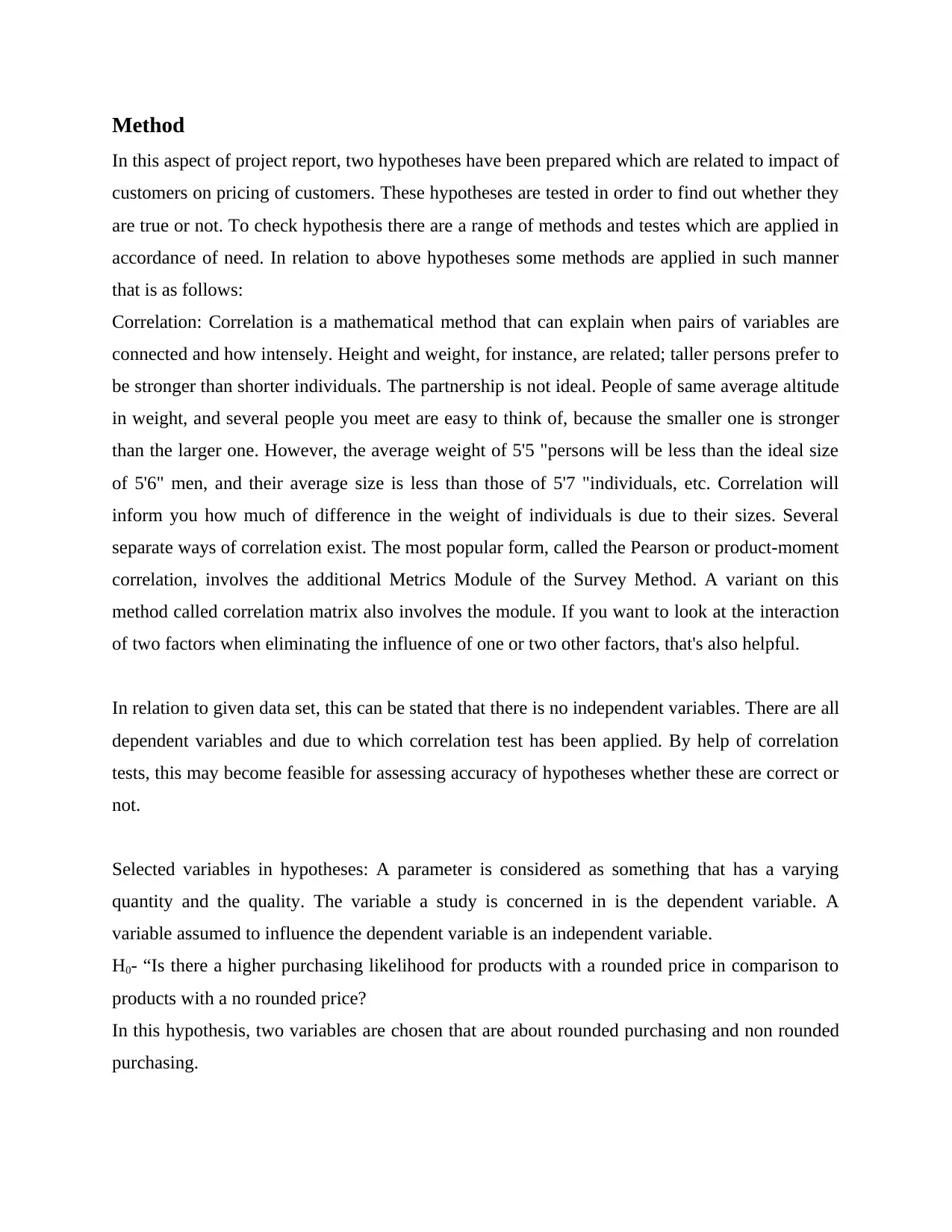
Method
In this aspect of project report, two hypotheses have been prepared which are related to impact of
customers on pricing of customers. These hypotheses are tested in order to find out whether they
are true or not. To check hypothesis there are a range of methods and testes which are applied in
accordance of need. In relation to above hypotheses some methods are applied in such manner
that is as follows:
Correlation: Correlation is a mathematical method that can explain when pairs of variables are
connected and how intensely. Height and weight, for instance, are related; taller persons prefer to
be stronger than shorter individuals. The partnership is not ideal. People of same average altitude
in weight, and several people you meet are easy to think of, because the smaller one is stronger
than the larger one. However, the average weight of 5'5 "persons will be less than the ideal size
of 5'6" men, and their average size is less than those of 5'7 "individuals, etc. Correlation will
inform you how much of difference in the weight of individuals is due to their sizes. Several
separate ways of correlation exist. The most popular form, called the Pearson or product-moment
correlation, involves the additional Metrics Module of the Survey Method. A variant on this
method called correlation matrix also involves the module. If you want to look at the interaction
of two factors when eliminating the influence of one or two other factors, that's also helpful.
In relation to given data set, this can be stated that there is no independent variables. There are all
dependent variables and due to which correlation test has been applied. By help of correlation
tests, this may become feasible for assessing accuracy of hypotheses whether these are correct or
not.
Selected variables in hypotheses: A parameter is considered as something that has a varying
quantity and the quality. The variable a study is concerned in is the dependent variable. A
variable assumed to influence the dependent variable is an independent variable.
H0- “Is there a higher purchasing likelihood for products with a rounded price in comparison to
products with a no rounded price?
In this hypothesis, two variables are chosen that are about rounded purchasing and non rounded
purchasing.
In this aspect of project report, two hypotheses have been prepared which are related to impact of
customers on pricing of customers. These hypotheses are tested in order to find out whether they
are true or not. To check hypothesis there are a range of methods and testes which are applied in
accordance of need. In relation to above hypotheses some methods are applied in such manner
that is as follows:
Correlation: Correlation is a mathematical method that can explain when pairs of variables are
connected and how intensely. Height and weight, for instance, are related; taller persons prefer to
be stronger than shorter individuals. The partnership is not ideal. People of same average altitude
in weight, and several people you meet are easy to think of, because the smaller one is stronger
than the larger one. However, the average weight of 5'5 "persons will be less than the ideal size
of 5'6" men, and their average size is less than those of 5'7 "individuals, etc. Correlation will
inform you how much of difference in the weight of individuals is due to their sizes. Several
separate ways of correlation exist. The most popular form, called the Pearson or product-moment
correlation, involves the additional Metrics Module of the Survey Method. A variant on this
method called correlation matrix also involves the module. If you want to look at the interaction
of two factors when eliminating the influence of one or two other factors, that's also helpful.
In relation to given data set, this can be stated that there is no independent variables. There are all
dependent variables and due to which correlation test has been applied. By help of correlation
tests, this may become feasible for assessing accuracy of hypotheses whether these are correct or
not.
Selected variables in hypotheses: A parameter is considered as something that has a varying
quantity and the quality. The variable a study is concerned in is the dependent variable. A
variable assumed to influence the dependent variable is an independent variable.
H0- “Is there a higher purchasing likelihood for products with a rounded price in comparison to
products with a no rounded price?
In this hypothesis, two variables are chosen that are about rounded purchasing and non rounded
purchasing.
⊘ This is a preview!⊘
Do you want full access?
Subscribe today to unlock all pages.

Trusted by 1+ million students worldwide
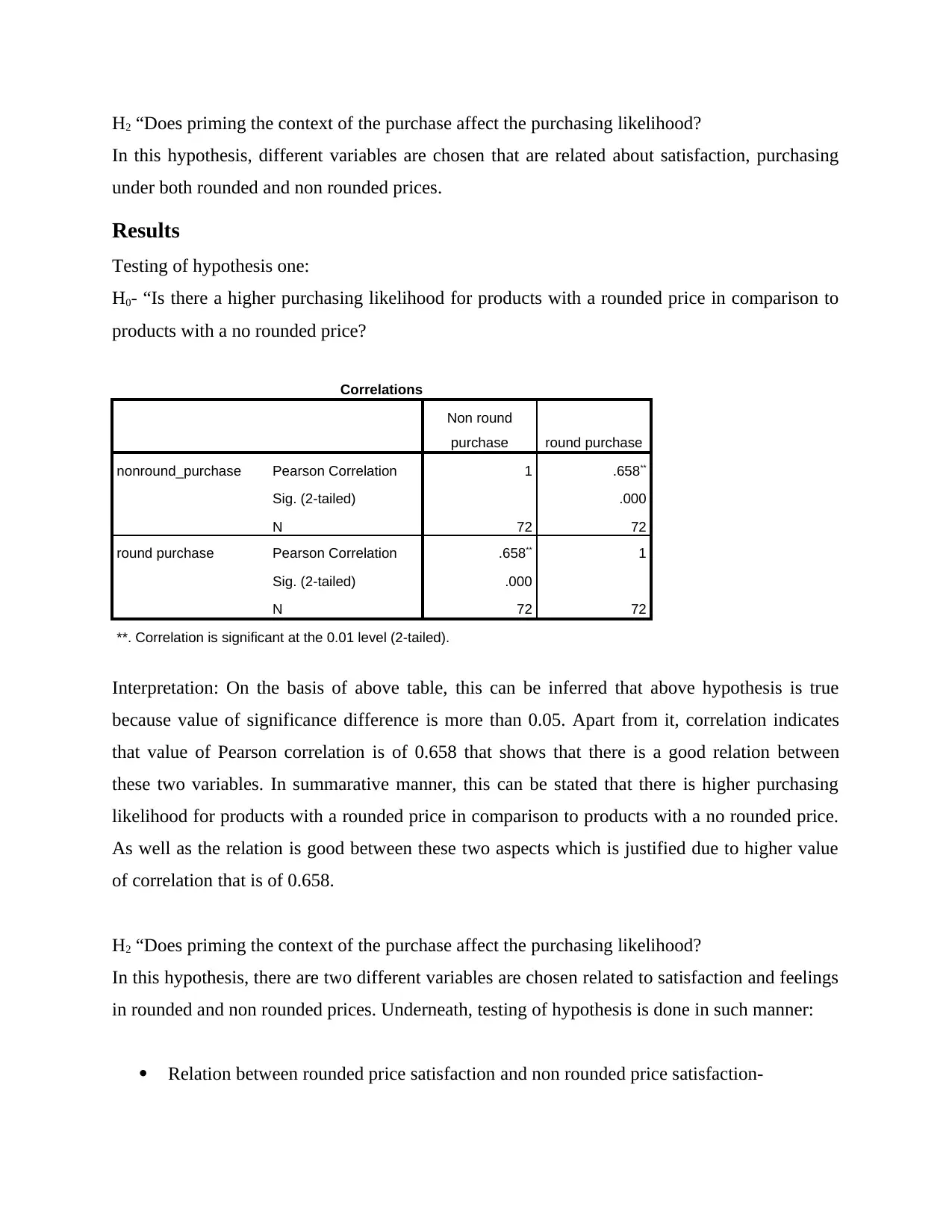
H2 “Does priming the context of the purchase affect the purchasing likelihood?
In this hypothesis, different variables are chosen that are related about satisfaction, purchasing
under both rounded and non rounded prices.
Results
Testing of hypothesis one:
H0- “Is there a higher purchasing likelihood for products with a rounded price in comparison to
products with a no rounded price?
Correlations
Non round
purchase round purchase
nonround_purchase Pearson Correlation 1 .658**
Sig. (2-tailed) .000
N 72 72
round purchase Pearson Correlation .658** 1
Sig. (2-tailed) .000
N 72 72
**. Correlation is significant at the 0.01 level (2-tailed).
Interpretation: On the basis of above table, this can be inferred that above hypothesis is true
because value of significance difference is more than 0.05. Apart from it, correlation indicates
that value of Pearson correlation is of 0.658 that shows that there is a good relation between
these two variables. In summarative manner, this can be stated that there is higher purchasing
likelihood for products with a rounded price in comparison to products with a no rounded price.
As well as the relation is good between these two aspects which is justified due to higher value
of correlation that is of 0.658.
H2 “Does priming the context of the purchase affect the purchasing likelihood?
In this hypothesis, there are two different variables are chosen related to satisfaction and feelings
in rounded and non rounded prices. Underneath, testing of hypothesis is done in such manner:
Relation between rounded price satisfaction and non rounded price satisfaction-
In this hypothesis, different variables are chosen that are related about satisfaction, purchasing
under both rounded and non rounded prices.
Results
Testing of hypothesis one:
H0- “Is there a higher purchasing likelihood for products with a rounded price in comparison to
products with a no rounded price?
Correlations
Non round
purchase round purchase
nonround_purchase Pearson Correlation 1 .658**
Sig. (2-tailed) .000
N 72 72
round purchase Pearson Correlation .658** 1
Sig. (2-tailed) .000
N 72 72
**. Correlation is significant at the 0.01 level (2-tailed).
Interpretation: On the basis of above table, this can be inferred that above hypothesis is true
because value of significance difference is more than 0.05. Apart from it, correlation indicates
that value of Pearson correlation is of 0.658 that shows that there is a good relation between
these two variables. In summarative manner, this can be stated that there is higher purchasing
likelihood for products with a rounded price in comparison to products with a no rounded price.
As well as the relation is good between these two aspects which is justified due to higher value
of correlation that is of 0.658.
H2 “Does priming the context of the purchase affect the purchasing likelihood?
In this hypothesis, there are two different variables are chosen related to satisfaction and feelings
in rounded and non rounded prices. Underneath, testing of hypothesis is done in such manner:
Relation between rounded price satisfaction and non rounded price satisfaction-
Paraphrase This Document
Need a fresh take? Get an instant paraphrase of this document with our AI Paraphraser
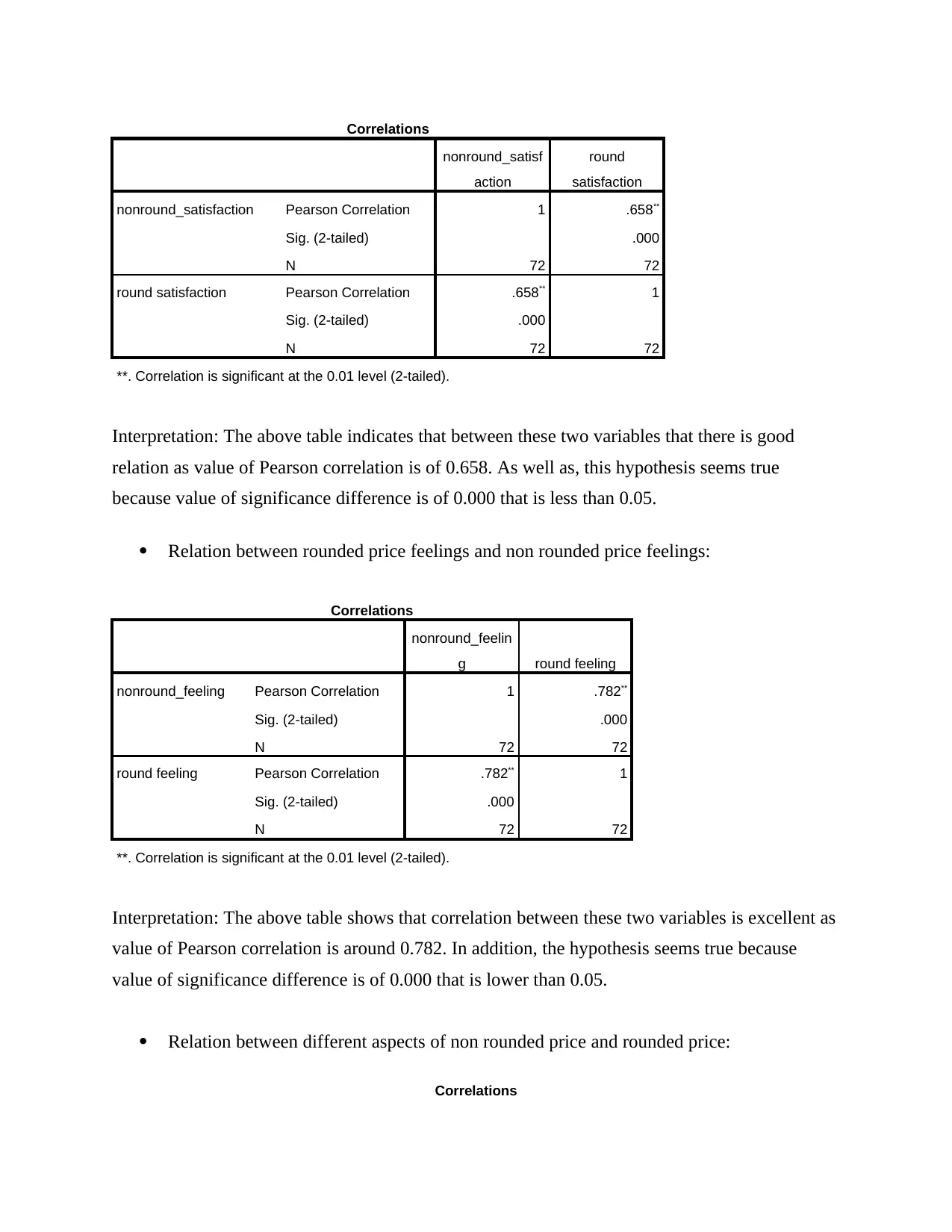
Correlations
nonround_satisf
action
round
satisfaction
nonround_satisfaction Pearson Correlation 1 .658**
Sig. (2-tailed) .000
N 72 72
round satisfaction Pearson Correlation .658** 1
Sig. (2-tailed) .000
N 72 72
**. Correlation is significant at the 0.01 level (2-tailed).
Interpretation: The above table indicates that between these two variables that there is good
relation as value of Pearson correlation is of 0.658. As well as, this hypothesis seems true
because value of significance difference is of 0.000 that is less than 0.05.
Relation between rounded price feelings and non rounded price feelings:
Correlations
nonround_feelin
g round feeling
nonround_feeling Pearson Correlation 1 .782**
Sig. (2-tailed) .000
N 72 72
round feeling Pearson Correlation .782** 1
Sig. (2-tailed) .000
N 72 72
**. Correlation is significant at the 0.01 level (2-tailed).
Interpretation: The above table shows that correlation between these two variables is excellent as
value of Pearson correlation is around 0.782. In addition, the hypothesis seems true because
value of significance difference is of 0.000 that is lower than 0.05.
Relation between different aspects of non rounded price and rounded price:
Correlations
nonround_satisf
action
round
satisfaction
nonround_satisfaction Pearson Correlation 1 .658**
Sig. (2-tailed) .000
N 72 72
round satisfaction Pearson Correlation .658** 1
Sig. (2-tailed) .000
N 72 72
**. Correlation is significant at the 0.01 level (2-tailed).
Interpretation: The above table indicates that between these two variables that there is good
relation as value of Pearson correlation is of 0.658. As well as, this hypothesis seems true
because value of significance difference is of 0.000 that is less than 0.05.
Relation between rounded price feelings and non rounded price feelings:
Correlations
nonround_feelin
g round feeling
nonround_feeling Pearson Correlation 1 .782**
Sig. (2-tailed) .000
N 72 72
round feeling Pearson Correlation .782** 1
Sig. (2-tailed) .000
N 72 72
**. Correlation is significant at the 0.01 level (2-tailed).
Interpretation: The above table shows that correlation between these two variables is excellent as
value of Pearson correlation is around 0.782. In addition, the hypothesis seems true because
value of significance difference is of 0.000 that is lower than 0.05.
Relation between different aspects of non rounded price and rounded price:
Correlations
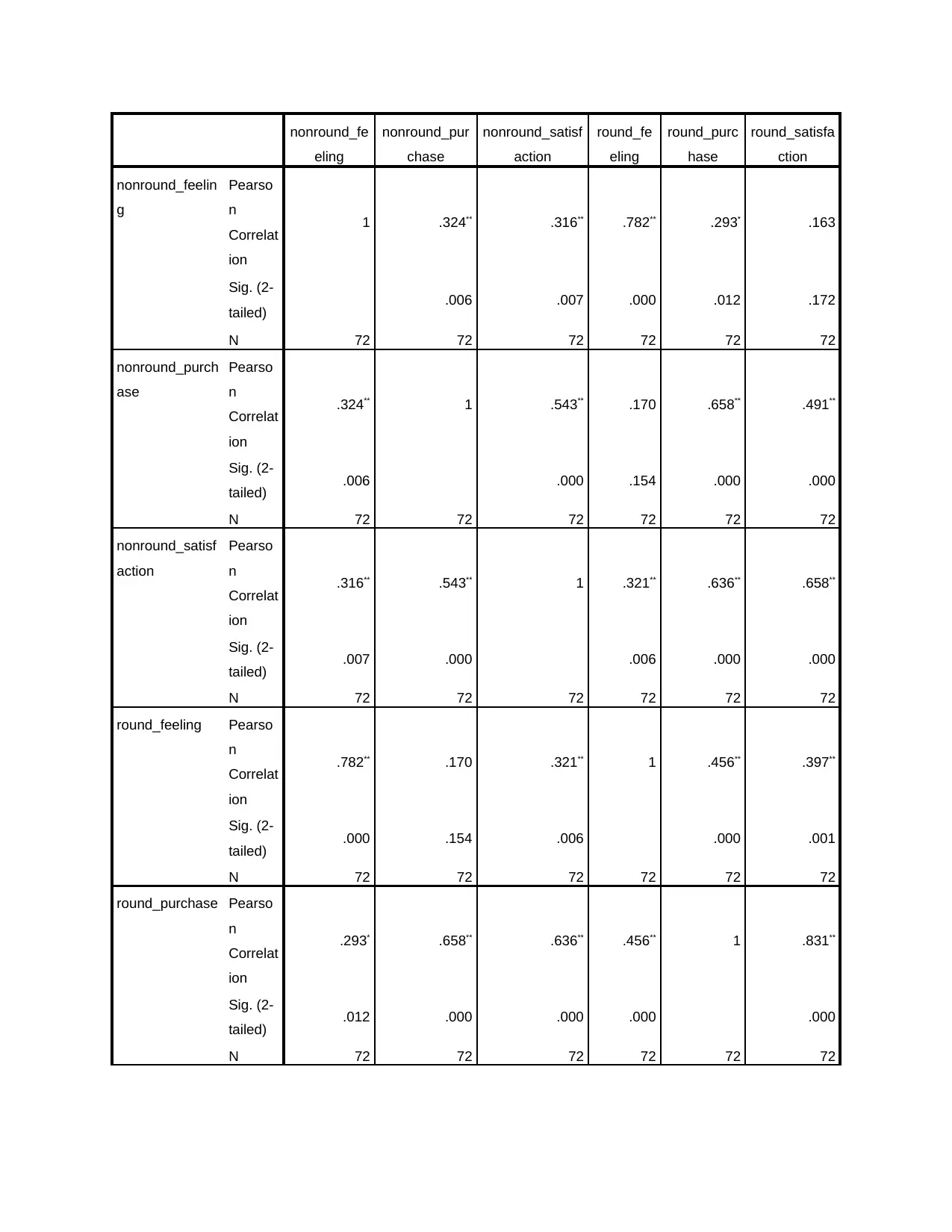
nonround_fe
eling
nonround_pur
chase
nonround_satisf
action
round_fe
eling
round_purc
hase
round_satisfa
ction
nonround_feelin
g
Pearso
n
Correlat
ion
1 .324** .316** .782** .293* .163
Sig. (2-
tailed) .006 .007 .000 .012 .172
N 72 72 72 72 72 72
nonround_purch
ase
Pearso
n
Correlat
ion
.324** 1 .543** .170 .658** .491**
Sig. (2-
tailed) .006 .000 .154 .000 .000
N 72 72 72 72 72 72
nonround_satisf
action
Pearso
n
Correlat
ion
.316** .543** 1 .321** .636** .658**
Sig. (2-
tailed) .007 .000 .006 .000 .000
N 72 72 72 72 72 72
round_feeling Pearso
n
Correlat
ion
.782** .170 .321** 1 .456** .397**
Sig. (2-
tailed) .000 .154 .006 .000 .001
N 72 72 72 72 72 72
round_purchase Pearso
n
Correlat
ion
.293* .658** .636** .456** 1 .831**
Sig. (2-
tailed) .012 .000 .000 .000 .000
N 72 72 72 72 72 72
eling
nonround_pur
chase
nonround_satisf
action
round_fe
eling
round_purc
hase
round_satisfa
ction
nonround_feelin
g
Pearso
n
Correlat
ion
1 .324** .316** .782** .293* .163
Sig. (2-
tailed) .006 .007 .000 .012 .172
N 72 72 72 72 72 72
nonround_purch
ase
Pearso
n
Correlat
ion
.324** 1 .543** .170 .658** .491**
Sig. (2-
tailed) .006 .000 .154 .000 .000
N 72 72 72 72 72 72
nonround_satisf
action
Pearso
n
Correlat
ion
.316** .543** 1 .321** .636** .658**
Sig. (2-
tailed) .007 .000 .006 .000 .000
N 72 72 72 72 72 72
round_feeling Pearso
n
Correlat
ion
.782** .170 .321** 1 .456** .397**
Sig. (2-
tailed) .000 .154 .006 .000 .001
N 72 72 72 72 72 72
round_purchase Pearso
n
Correlat
ion
.293* .658** .636** .456** 1 .831**
Sig. (2-
tailed) .012 .000 .000 .000 .000
N 72 72 72 72 72 72
⊘ This is a preview!⊘
Do you want full access?
Subscribe today to unlock all pages.

Trusted by 1+ million students worldwide
1 out of 18
Your All-in-One AI-Powered Toolkit for Academic Success.
+13062052269
info@desklib.com
Available 24*7 on WhatsApp / Email
![[object Object]](/_next/static/media/star-bottom.7253800d.svg)
Unlock your academic potential
Copyright © 2020–2025 A2Z Services. All Rights Reserved. Developed and managed by ZUCOL.
